In the Streets Get Cut Out Beef Getting Cut Out
The Different Cuts of Beef
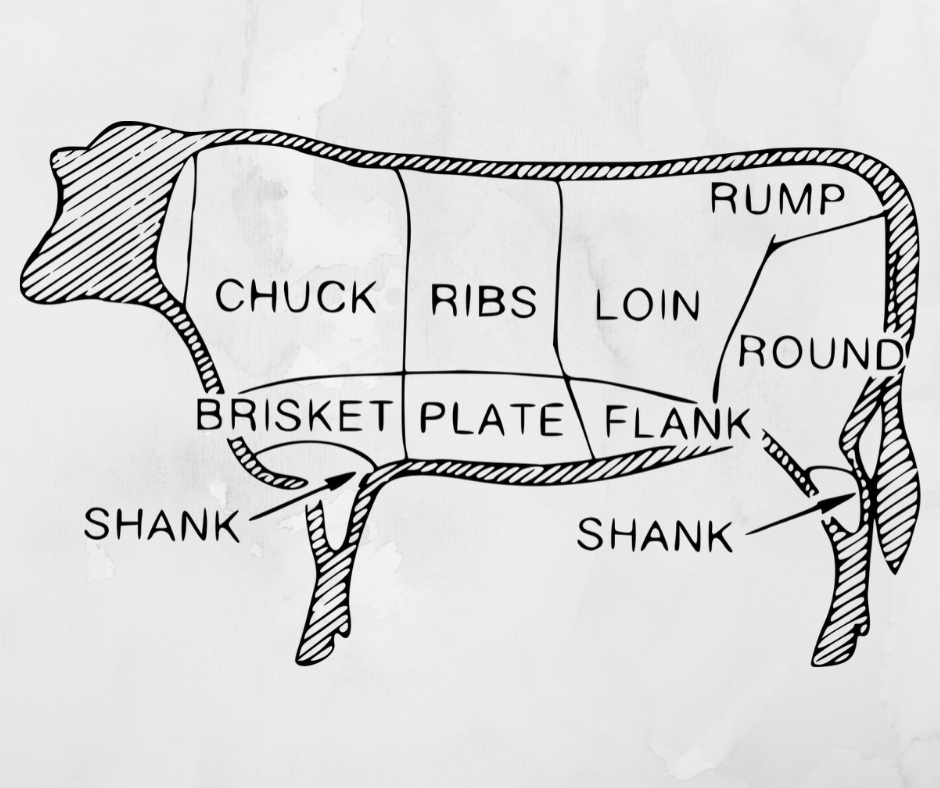
Beef is one of the most popular meats on American dinner tables. Did you know that, on average, Americans each consume over 67 pounds of beef? That's over one pound of beef every week. As much as most of us enjoy this meat, you may not know what separates one type from another. Butchers separate each part of a steer to create different cuts of beef. While all of these cuts are beef from the same cow, they can differ dramatically.
The muscle usage, marbling, bones and other factors all contribute to a unique flavor and texture profile for each cut of beef. So, how do you keep it all straight when you're looking to buy something delicious to enjoy for dinner? We've created a cuts of beef guide that will provide you with an easy overview of each primal and subprimal cut of beef. We'll also talk about the best ways to prepare these cuts so you can enjoy naturally tasty beef.
What are the 8 Primal Cuts of Beef?
Let's start by looking at the primal cuts of beef. These are the eight basic cuts that separate one whole side of beef. These cuts incorporate large sections that get cut down further to form subprimal cuts and individual portion cuts of meat you might buy at the butcher shop or grocery store. These eight different cuts of meat include the following.
- Chuck: Beef chuck comes from the forequarter of a cow. Chuck consists of the upper arm through the shoulder blade up to part of the neck.
- Rib:The rib cut consists of the sixth through the 12th ribs, not including the lower portion, which is known as the plate.
- Loin:On the top of the cow, just behind the rib, is the loin. The loin is where the highest-quality cuts of beef come from.
- Round:The round is at the back of the cow, on the rump and hind legs.
- Flank:The flank is a boneless cut of meat located below the loin.
- Plate:The plate, also called the short plate, is below the rib cut, in the forequarter of the cow.
- Brisket:In the front of the cow, below the chuck, is the brisket cut. This cut is from the cow's breastbone area.
- Shank:The shank is the upper part of the cow's legs. Each side of beef includes two shanks: one in the forequarter and one in the back.
What are the Subprimal Cuts of Beef?
If you've purchased beef from a butcher or supermarket, you know beef comes in far more than just eight different cuts. That's because butchers can further divide each primal cut of beef into smaller sections known as subprimal cuts. You can often find subprimal cuts cut down even further into individual cuts at the grocery store.
Now that we've looked at the eight primal cuts of beef, let's turn our attention to the subprimal cuts that belong to each primal cut and how to prepare these cuts to bring out their best textures and flavors.
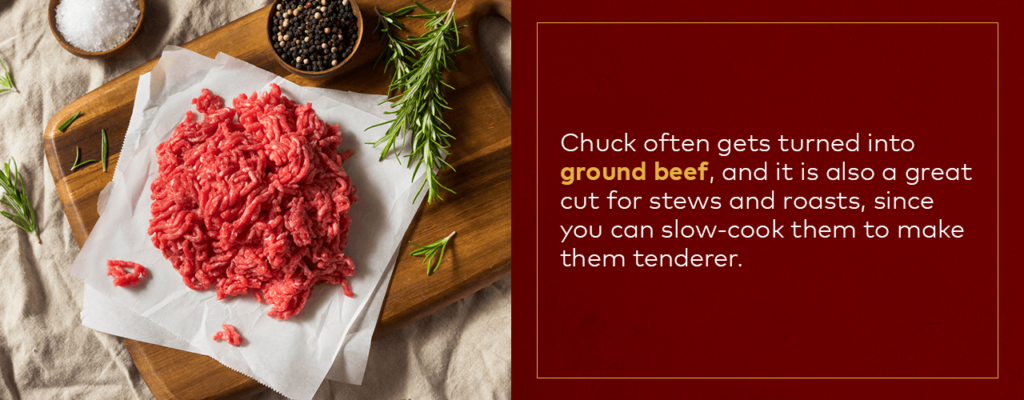
1. Chuck Subprimal Cuts
Because it includes a lot of connective tissue, the chuck primal cut is relatively tough. Chuck is also high in fat content, which contributes to a rich flavor. Chuck often gets turned into ground beef, and it is also a great cut for stews and roasts, since you can slow-cook them to make them tenderer. Let's take a closer look at the subprimal cuts of beef chuck.
- Chuck tender:Chuck tender is a lean cut divided further into chuck tender steak and chuck tender roast. If you want to grill a chuck tender steak, you'll want to marinade it first to tenderize it.
- Chuck roll:Chuck roll is more tender. It consists of two cuts, chuck eye roll and under blade, which produce a range of flavorful roasts, country-style ribs, steaks and more.
- Shoulder clod: The shoulder clod includes the shoulder clod arm roast and shoulder petite tender, which are lean, and the more marbled top blade. In addition to slow-cooking, you can grill, broil or smoke the shoulder petite tender.
- Square-cut chuck:This cut is flavorful and tender due to marbling. It consists of many varieties of steaks and roasts, along with pectoral meat and short ribs. You can grill or broil some cuts instead of putting them in a slow cooker.
2. Rib Subprimal Cuts
All-time favorite beef cuts like the ribeye steak and prime rib roast come from the rib cut. There are only two subprimal cuts, but both of these subprimal sections include many popular cuts of beef. Because the beef rib section is tender and flavorful, these cuts are versatile, and you can cook them to perfection in many different ways.
- Ribeye roll:The ribeye roll includes ribeye steaks and roasts, all of which are rich, juicy and tender. The best ways to prepare ribeye roasts are through roasting or baking, and there are a variety of ways to prepare steaks, including grilling, pan-broiling, smoking and more. Ribeye steaks and roasts are a favorite cut of meat for their delicious flavor and succulent texture.
- Rib subprimal:This subprimal cut includes back ribs, short ribs and rib oven-prepared, all of which are tender, delicious ribs. As the name suggests, rib oven is best roasted, while there are a variety of ways to prepare back ribs and short ribs. This subprimal also includes rib fingers and blade/lifter meat.
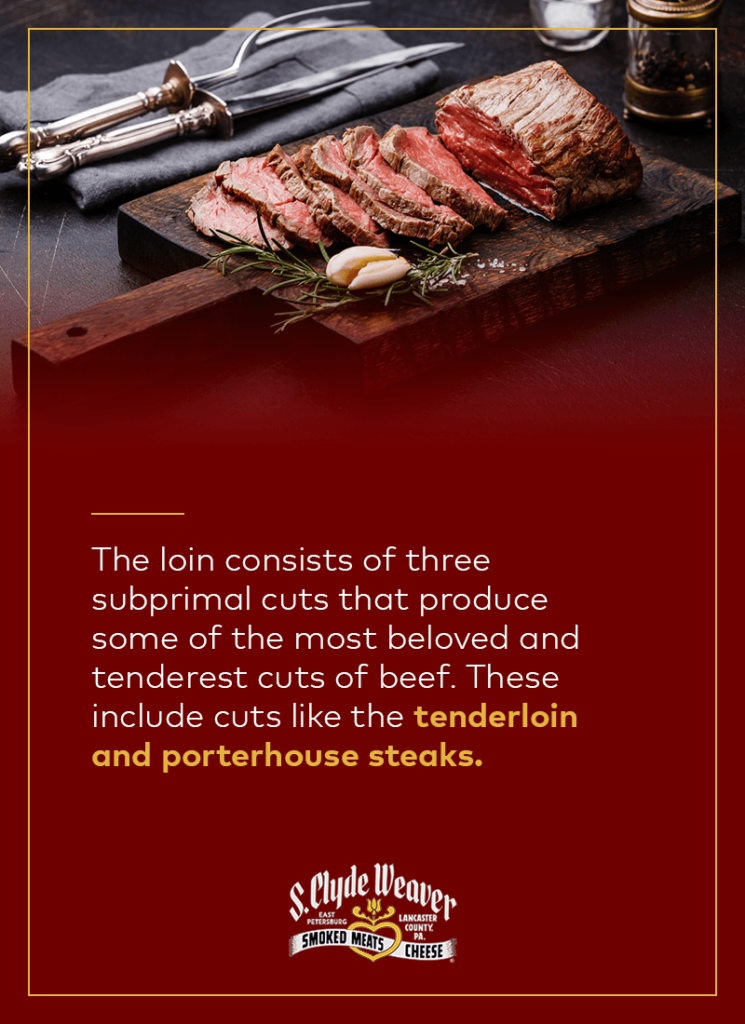
3. Loin Subprimal Cuts
The loin consists of three subprimal cuts that produce some of the most beloved and tenderest cuts of beef. These include cuts like the tenderloin and porterhouse steaks. Many loin cuts are lean, but they are still tender because of their location on the steer.
You should bake or roast butts and roasts, and brown tips in a skillet. You can prepare the other loin cuts in a variety of ways according to your preference. Grilling and pan-searing are popular methods for bringing out the delicious flavors in steaks that come from loin subprimal cuts.
- Tenderloin:The tenderloin is a long, narrow section of meat known for being the tenderest of all. The famous filet mignon comes from this subprimal cut, as well as tenderloin roast, tips, tails and butt.
- Strip loin:The strip loin is a boneless cut of meat with generous marbling and delicious flavor. You can prepare it whole as a roast, or subdivide into strip filet, strip petite roast, strip roast and strip steak.
- Short loin:The short loin is another popular subprimal cut for steak lovers. It produces the porterhouse steak and T-bone steak, along with the loin steak tail. These cuts offer bold flavor.
4. Round Subprimal Cuts
The round primal cut is relatively inexpensive and can be a bit tough. Most cuts from the beef round section are lean and have a lower fat content. Still, this primal cut produces some subprimal cuts that are useful and delicious for all sorts of dishes. They may require some marinating or slow-cooking to become tender. Marinating is the method of choice in most cases for steak, and slow-cooking is the best way to tenderize roasts.
- Bottom round:Bottom round is a lean subprimal cut from the outside of the steer's rear leg. Bottom round consists of two sections: outside round, cut into roasts and steaks, and outside round, or heel, which you can grind or cut into steaks. These cuts are typically best braised or roasted and sliced. For steak cuts, marinate before cooking.
- Eye of round:Eye of round is exceptionally lean and is similar to a tenderloin, though it is much tougher in comparison. It consists of eye of round roast and eye of round steak. The roast is a popular choice for roast beef sandwiches. You can also bake or braise it and enjoy it as a roast. Marinate eye of round steak, then cook it on a grill or in a skillet.
- Sirloin tip:The sirloin tip, also called knuckle, consists of sirloin roasts and steaks. You can also grind it to create ground beef. Sirloin tip is extremely lean. The best ways to prepare roasts include braising, baking or roasting. You can also braise steaks or marinate them before grilling or broiling.
- Top round:The last subprimal cut from the round primal is top round. Also called inside round, top round is lean and is a popular choice for making sliced roast beef. In addition to roasts, you can also use top round to create inexpensive steaks. These steaks benefit from marinating before cooking.
5. Flank Subprimal Cut
The beef flank primal cut produces just one subprimal cut: flank steak. Also called London broil, jiffy steak or plank steak, flank steak is lean and flavorful. Flank steak is a good choice for ground beef. You can also broil a flank steak, slice it up and stir-fry it or can marinate and grill it and then slice it.
When grilling flank steak, the key is to cook the steak at a high temperature over a short period. Be careful not to overcook the flank steak so that it remains moist rather than drying out. Once you've cooked the steak, cut it into thin slices, going against the grain.
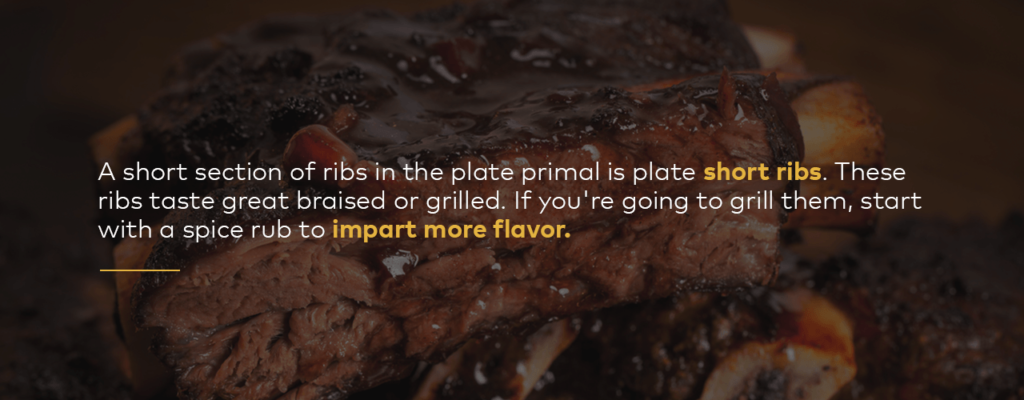
6. Plate Subprimal Cuts
The plate primal offers five subprimal cuts. Unlike many of the beef cuts we've looked at, which are best to prepare through slow-cooking methods, many plate subprimal cuts are well-suited to fast cooking over high heat.
- Hanger steak:The hanger steak is a thick, flavorful cut. It has a coarse texture, but you can tenderize it by removing some connective tissue membrane or marinating the steak. Then, you can grill or broil the hanger steak over high heat.
- Inside skirt steak: The inside skirt steak is especially flavorful, and is a favorite subprimal cut for making fajitas or beef stir-fry. For extra flavor and to tenderize the meat a bit, marinate it before cooking strips of inside skirt steak for a short time over high heat.
- Outside skirt steak:The outside skirt steak sits opposite from inside skirt steak, but this subprimal cut is similar to the inside skirt steak. It's also known for fajitas, so you may see it labeled as fajita meat in some instances.
- Plate short ribs:A short section of ribs in the plate primal is plate short ribs. These ribs taste great braised or grilled. If you're going to grill them, start with a spice rub to impart more flavor.
- Flanken-style short ribs:Flanken-style short ribs, also sometimes referred to as Korean-style short ribs, get cut across the rib bones rather than between each bone. They are an excellent choice for grilling. Be sure to marinate them first.
7. Brisket Subprimal Cuts
Beef brisket is flavorful, but it can be a bit tough, since it comes from a muscle that cows often use in their daily life. Slow-cooking is, therefore, a smart method of cooking brisket, so it becomes tender as it cooks. Brisket is divided into two subprimal cuts: flat half and point half.
- Brisket flat half:This portion of the brisket comes from the posterior part and is relatively thin, hence the name flat half. You may also hear people call it the "first cut." In addition to traditional methods of slow-cooking, you can try other cooking methods, such as pressure cooking, smoking or even sous vide.
- Brisket point half:The point half of the brisket is fattier and is exceptionally flavorful. You still want to cook it low and slow in most cases, though, to end up with a tender cut of meat you can cut or shred. This cut is not as well-suited to pressure cooking, but you can braise, roast, bake, smoke or sous-vide.
8. Beef Shank Subprimal Cut
Last on our list of beef cuts is the shank. The shank primal is a section of the leg, so the cow uses these muscles quite a lot. For this reason, shank meat can be tough by default, but cooking it low and slow can cause it to become very tender.
There is only one subprimal cut of the shank primal to be aware of: shank cross-cut. This lean cut is best known for the Italian dish osso buco, where it is the star of the show. Braising it leads to fork-tender meat.
Quality Smoked Meats, Cheeses and More From S. Clyde Weaver
At S. Clyde Weaver, we understand meat. That's because, for over 100 years, we've been smoking, aging and otherwise preparing delicious meats and cheeses that bring the culinary heritage of Lancaster County to your table. Even though we don't carry fresh beef online or in-store, we do create delicious beef delicacies like gourmet jerky and snack sticks or thin-sliced smoked dried beef, made from top-quality beef knuckles. Browse through our online store to see what S. Clyde Weaver products you want to try at your next picnic, family dinner or holiday gathering.
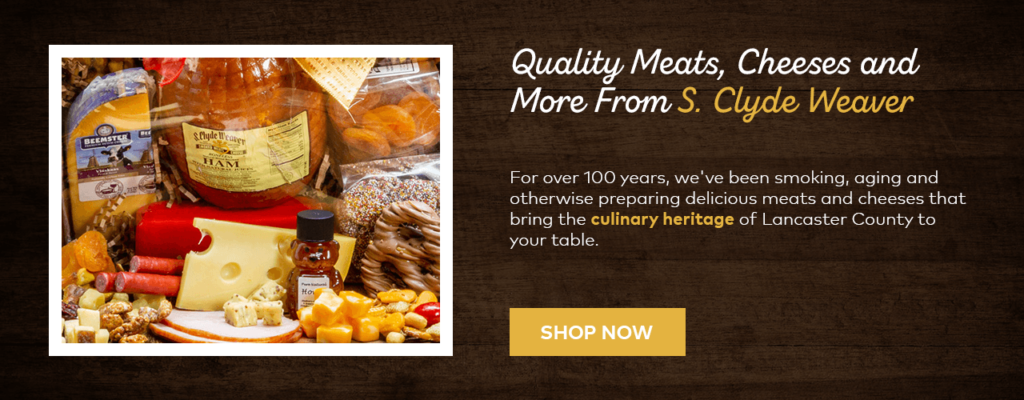
Source: https://sclydeweaver.com/blog/the-different-cuts-of-beef/
0 Response to "In the Streets Get Cut Out Beef Getting Cut Out"
Post a Comment